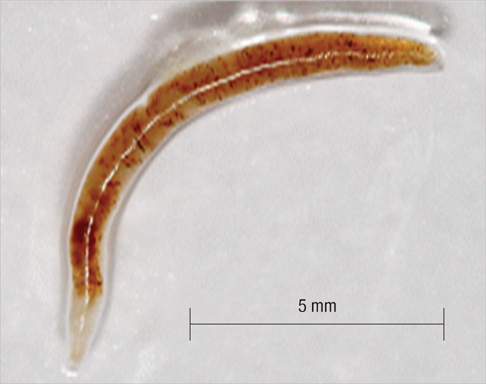J Korean Med Sci.
2010 Dec;25(12):1802-1804. 10.3346/jkms.2010.25.12.1802.
A Case of Severe Anemia by Necator americanus Infection in Korea
- Affiliations
-
- 1Department of Internal Medicine, National Police Hospital, Seoul, Korea.
- 2Department of Parasitology and Tropical Medicine, and Institute of Endemic Diseases, Seoul National University College of Medicine, Seoul, Korea. hst@snu.ac.kr
- KMID: 1792907
- DOI: http://doi.org/10.3346/jkms.2010.25.12.1802
Abstract
- This report describes clinical and parasitological findings of an 82-yr-old female patient who lived in a local rural village and suffered from severe chronic anemia for several years. She was transferred to the National Police Hospital in Seoul for management of severe dyspnea and dizziness. At admission, she showed symptoms or signs of severe anemia. Gastroduodenoscopy observed hyperemic mucosa of the duodenum and discovered numerous moving roundworms on the mucosa. Endoscopy isolated seven of them, which were identified as Necator americanus by characteristic morphology of cutting plates in the buccal cavity. The patient was treated with albendazole and supportive measures for anemia, and her physical condition much improved. This case suggests the possibility that hookworm N. americanus is still transmitted in a remote local mountainous area in Korea.
Keyword
MeSH Terms
Figure
Reference
-
1. Hotez PJ, Bethony J, Bottazzi ME, Brooker S, Buss P. Hookworm: "the great infection of mankind". PLoS Med. 2005. 2:e67.
Article2. Brooker S, Bethony J, Hotez PJ. Human hookworm infection in the 21st century. Adv Parasitol. 2004. 58:197–288.
Article3. Hong ST, Chai JY, Choi MH, Huh S, Rim HJ, Lee SH. A successful experience of soil-transmitted helminth control in the Republic of Korea. Korean J Parasitol. 2006. 44:177–185.
Article4. Lee MK, Hong SJ, Kim HR. Seroprevalence of tissue invading parasitic infections diagnosed by ELISA in Korea. J Korean Med Sci. 2010. 25:1272–1276.
Article5. Korea Association of Health Promotion. Prevalence of intestinal parasitic infection in Korea: the 7th Report. 2004. Seoul: Korea Association of Health Promotion.6. Rim HJ, Won CY, Lee SI, Lim JK. Anthelmintic effect of oxantel pamoate and pyrantel pamoate suspension against intestinal nematode infestations. Korean J Parasitol. 1975. 13:97–101.
Article7. Joo KH, Rim HJ. Epidemiological study on the hookworm infections in Korea. Korean J Parasitol. 1978. 16:103–112.
Article8. Hong ST. A survey on intestinal parasites of soldiers in Korea. Korean J Parasitol. 1986. 24:213–215.
Article9. Yong TS, Shin HJ, Im KI, Kim WH. An imported human case of hookworm infection with worms in the rectum. Korean J Parasitol. 1992. 30:59–62.
Article10. Reddy SC, Vega KJ. Endoscopic diagnosis of chronic severe upper GI bleeding due to helminthic infection. Gastrointest Endosc. 2008. 67:990–992.
Article
- Full Text Links
- Actions
-
Cited
- CITED
-
- Close
- Share
- Similar articles
-
- Further observations on the prevalence of Ancylostoma duodenale and Necator americanus in the Taegu area
- Molecular Detection of Ancylostoma duodenale, Ancylostoma ceylanicum, and Necator americanus in Humans in Northeastern and Southern Thailand
- Epidemiological study on the hookworm infections in Korea
- Hookworm Infection: A Neglected Cause of Overt Obscure Gastrointestinal Bleeding
- Prevalence of Soil-Transmitted Helminths and Molecular Clarification of Hookworm Species in Ethnic Ede Primary Schoolchildren in Dak Lak Province, Southern Vietnam




